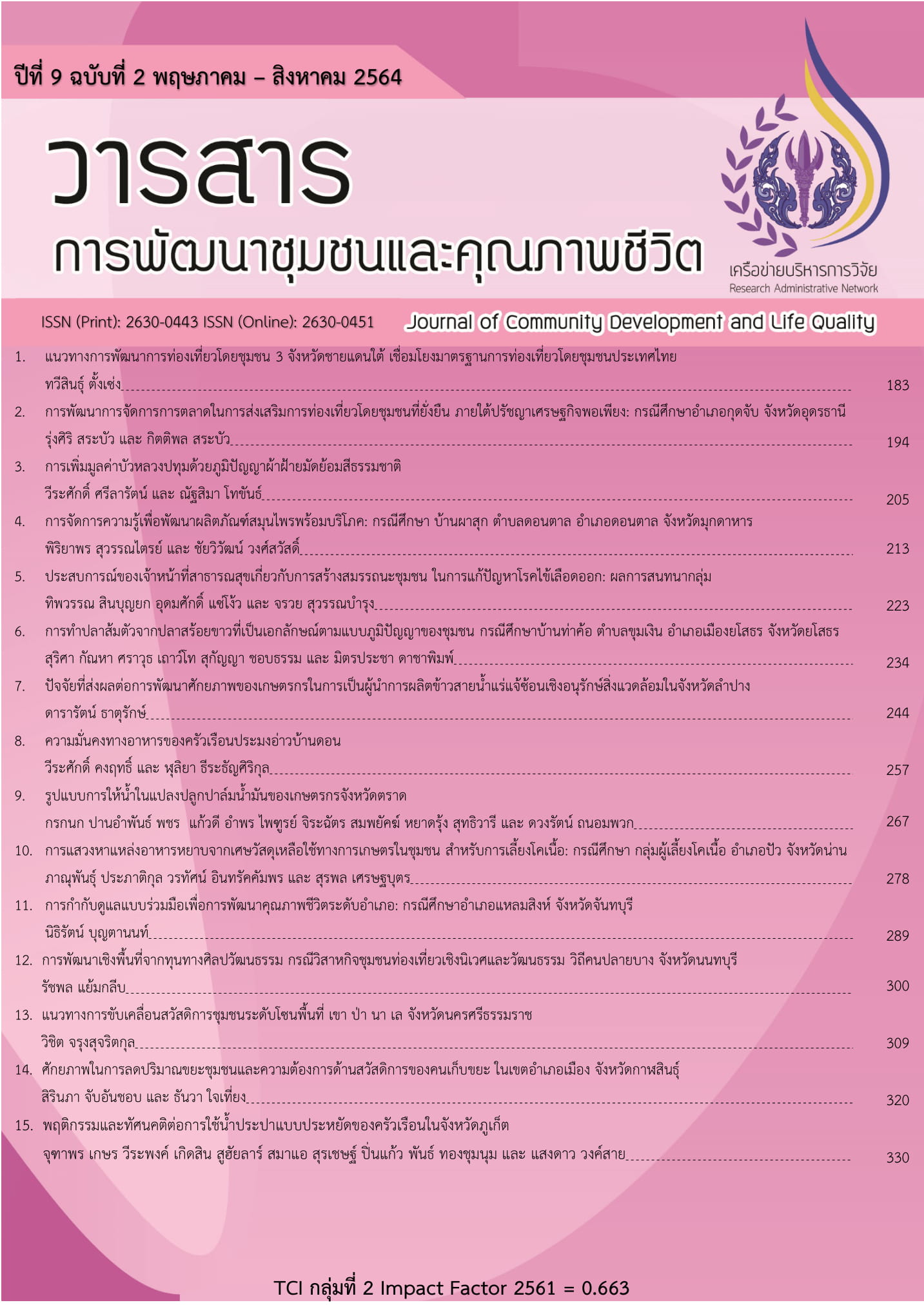การพัฒนาเชิงพื้นที่จากทุนทางศิลปวัฒนธรรม กรณีวิสาหกิจชุมชนท่องเที่ยวเชิงนิเวศและวัฒนธรรม วิถีคนปลายบาง จังหวัดนนทบุรี
Main Article Content
บทคัดย่อ
การวิจัยนี้มีวัตถุประสงค์เพื่อศึกษาข้อมูลการนำทุนทางศิลปวัฒนธรรมมาใช้เป็นส่วนหนึ่งในกระบวนการดำเนินงานวิสาหกิจชุมชนท่องเที่ยวเชิงนิเวศและวัฒนธรรม วิถีคนปลายบาง จังหวัดนนทบุรี เพื่อเสนอแนวทางสำหรับการพัฒนาเชิงพื้นที่ในอนาคต ผ่านภาคีเครือข่าย หรือผู้มีส่วนได้ส่วนเสีย การวิจัยถูกศึกษาผ่านแนวคิดการพัฒนาเชิงพื้นที่และการมีส่วนร่วมของชุมชน และอาศัยระเบียบวิธีวิจัยเชิงคุณภาพ เน้นสำรวจทรัพยากรมรดกทางศิลปวัฒนธรรมทั้งที่จับต้องได้และจับต้องไม่ได้ในพื้นที่ กระบวนการนำทรัพยากรเหล่านั้นมาใช้ในการดำเนินงานของวิสาหกิจชุมชน ตลอดจนจุดแข็งและความท้าทายของการนำศิลปวัฒนธรรมมาใช้ ผลการศึกษาพบว่า วิสาหกิจชุมชนท่องเที่ยวเชิงนิเวศและวัฒนธรรม วิถีคนปลายบาง จังหวัดนนทบุรี ถือกำเนิดจากความพยายามพลิกฟื้นผืนแผ่นดินที่เคยได้รับผลกระทบจากมหาอุทกภัยเมื่อปี พ.ศ. 2554 สู่การเป็นชุมชนที่สามารถเลี้ยงชีพอย่างยั่งยืนผ่านมรดกทางวัฒนธรรมทั้งที่จับต้องได้อย่างโบราณสถาน โบราณวัตถุในชุมชน และที่จับต้องไม่ได้อย่างวิถีชีวิตริมคลองมหาสวัสดิ์ที่สืบทอดอย่างยาวนาน อย่างไรก็ตามการดำเนินงานของวิสาหกิจชุมชนก็ยังมีโอกาสสามารถพัฒนาต่อได้ผ่านความร่วมมือของภาคีเครือข่าย ที่สามารถเข้ามาช่วยด้วยสร้างเอกลักษณ์และเพิ่มการประชาสัมพันธ์ ตลอดจนขับเคลื่อนทรัพยากรศิลปวัฒนธรรมในพื้นที่สู่การเป็นพื้นที่ทางวัฒนธรรมที่มีระบบเศรษฐกิจที่ทั้งสร้างสรรค์และมีความยั่งยืน
Article Details
กองบรรณาธิการขอสงวนสิทธิ์ในการตรวจและแก้ไขบทความที่เสนอเพื่อตีพิมพ์ในวารสารการพัฒนาชุมชนและคุณภาพชีวิต
บทความหรือข้อความคิดเห็นใด ๆ ที่ปรากฏในวารสารการพัฒนาชุมชนและคุณภาพชีวิต เป็นวรรณกรรมของผู้เขียนโดยเฉพาะคณะผู้จัดทำไม่จำเป็นต้องเห็นด้วย และไม่ใช่ความรับผิดชอบของมหาวิทยาลัยและคณะผู้จัดทำ / บรรณาธิการ
เอกสารอ้างอิง
Castells, M. 1999. The Rise of the Network Society. Blackwell publisher, Oxford.
Champaw, S. and T. Promburom 2015. Guidelines for capacity development and community-based cultural tourism management in Tambon Ban Ruean, Pasang district, Lamphun province. Journal of Community Development and Life Quality 3(1): 5-16. (in Thai)
Cohen, J.M. and N.T. Uphoff. 1980. Participation’s place in rural development: Seeking clarity through specificity. World Developments 8(3): 213-235.
Higgins, M.D. 2007. The cultural space – not just location of the arts, but the Athens basis of creativity, source of innovation and the vindication of citizenship. A paper presented at the ECCM Symposium ‘Productivity of Culture’. (October 18, 2007)
ICOMOS Australia. 1999. The Burra Charter: The Australia ICOMOS Charter for Places of Cultural Significance. Australia ICOMOS, Australia.
Janvanichyanont, U., I. Janwithayanuchit, R. Timmaung, W. Thongkon, C. Changtam and T. Suntonanantachai. 2019. Economic value added of Bangbo Snakeskin Gourami supply chain according to the strategy of green agriculture and environmental friendliness, Samut Prakan province. Area Based Development Research Journal 11(2): 93 - 107. (in Thai)
Mitrchob, C. 2010. Creative economy: The new concept-driven economy of. Sukhothai Thammathirat Economic Journal 5(1): 81–114. (in Thai)
Punsin, P. 2012. Community participation in knowledge management of art and cultural: A case study of Sommanus community. Research and Development Journal 4(1): 60 - 66. (in Thai)
Satjawattana, K. 2017. Area-based collaborative research: A novel strategy to challenge a research paradigm of Thailand. Area Based Development Research Journal 9(1): 3 - 7. (in Thai)
Suanmalee, U., T. Juliratchaneekron and S. Panniem. 2019. Art and cultural communities in the area development of Phetchaburi province: A case study of the Napansam community. Research and Development Journal Suan Sunandha Rajabhat University 11(1): 22-31. (in Thai)
Suteetorn, B., K. Kaewsanga and A. Yoonaitharma. 2020. The public relations for creative tourism via social networking sites. Journal of Thai Hospitality and Tourism 15(2): 14-28. (in Thai)
Tiyawongsuwan, S., R. Harnpachern and S. Karisarasai. 2014. A study on integration of provincial potential development: Case study of Bueng Karn province. NAJUA: Architecture, Design and Built Environment 28(1): 299-320. (in Thai)
Treeaekanukul, L. 2017. Potential of community capital for being tourism special economic zone of Wiang Chiang Saen municipality, Chiang Rai province. Area Based Development Research Journal 10(2): 146 - 159. (in Thai)


